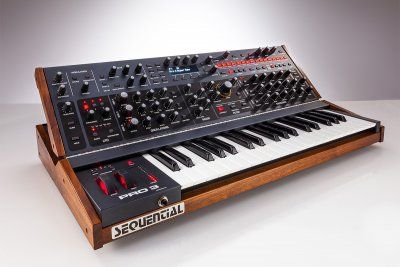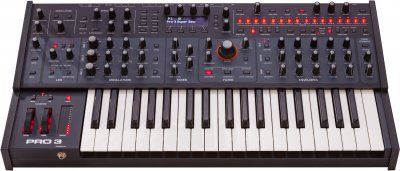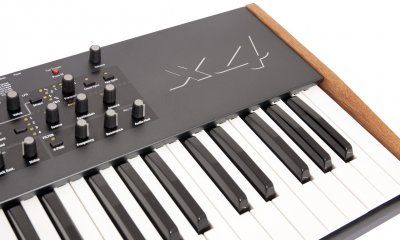Hier die aktuellen Specs aus dem GS-Thread (
https://www.gearslutz.com/board/ele...ic-production/1294542-sequential-pro-3-a.html)
Product Description
A Three-Generation Legacy
The Sequential Pro 1 and Pro 2 mono synths achieved nearly legendary status in their time. So it was only natural that we build on their strengths with an even more worthy successor. Enter the Pro 3, Sequential's 2-VCO + wavetable mono/paraphonic synth - a new benchmark for raw sonic power and unrivalled versatility.
The Power of 3
The Pro 3 boasts three oscillators, three vintage filters, three LFOs, four loopable envelopes, a massive 32-slot mod matrix, and an 16 x 16 x 4 sequencer. Throw in dual digital effects and four control voltage ins and outs, and you've got a hugely powerful instrument that's as exciting to program as it is to play.
A Next-Generation Classic
The Pro 3 is a hybrid of solid, old-school analog synthesis paired with versatile digital technology. Its two voltage controlled oscillators provide warmth and presence while its third wavetable oscillator provides digital edge and grit. With 32 tables of 16 waves each and wave morphing, tonal possibilities are immense. Tuned feedback with grunge, and analog distortion deliver industrial-grade nastiness on demand.
Three Filters Based on Vintage Designs
At the heart of the Pro 3's ballsy sound are its vintage-style filters. Filter 1 is a 4-pole lowpass design based on the
Prophet-6 filter.
Filter 2 is a classic transistor ladder filter with optional resonance compensation to preserve its low-end punch. Filter 3 is a classic
2-pole, state-variable design based on the
OB-6 filter that can be continuously varied between lowpass, notch, and high-pass operation, with an optional band-pass mode. An additional Drive control provides still more punch when you really want to get down and dirty.
Expressive Sequencing
Possibly the Pro 3's most powerful performance tool is its sequencer. With 16 tracks, 16 steps, and 4 phrases, it features both real-time and step input, ratcheting, variable gate and sequence lengths, multiple playback modes, and paraphonic operation. It also syncs to MIDI clock and external audio input, and inputs/outputs control voltages. In addition to notes, sequence tracks can control any parameter in the 132-destination modulation matrix.
Plays Well with Modulars
The Pro 3's flexible architecture opens the door to not only processing external audio, but also to interfacing with modular synths through its 4 rear-panel control voltage inputs/outputs and a dedicated gate output. Control voltages can be assigned and routed from within the modulation matrix and can run at audio rates for extreme modulation effects. Some of the many parameters that can be sent to the CV outputs include oscillators, LFOs, envelopes, and sequencer tracks, allowing the Pro 3 to become the central hub of a modular or multisynth setup.
Effects, Envelopes, LFOs, an Arpeggiator, and Extreme Modulation
The Pro 3's Effects section provides delays, reverbs, time-domain effects such as chorus/phasing/flanging and more. There are four loopable five-stage envelope generators, three syncable LFOs with slew and phase offset, a full-featured arpeggiator, and a 32-slot modulation matrix with dozens of modulation sources and over a hundred destinations.
Monophonic and Paraphonic Operation
The Pro 3 was designed to be a super-powerful monosynth, but it is also a versatile 3-voice paraphonic synth. This makes playing 3-note chords not only possible, but with creative use of effects and some per-oscillator modulation, mind-blowingly expressive.
Put all of this sonic power in a three-octave, semi-weighted keyboard with velocity and channel aftertouch, add backlit pitch and mod wheels and a location-sensitive touch slider, and you've got one of the most inspiring synths ever made.
Features
- Two analog, voltage-controlled oscillators
- One DSP-based digital oscillator
- Analog oscillators produce three classic wave shapes: (triangle, saw, pulse) with variable shape modulation/pulse width on each
- Digital oscillator produce 32 digital wavetables of 16 waves each with wave morphing, plus classic wave shapes (sine, triangle, saw, variable-width pulse) and super saw
- Digital oscillator 3 can function as an LFO for complex wavetable-based modulation
- White noise generator
- Hard sync, per-oscillator Glide, Oscillator Slop
- 3-voice paraphonic mode with individually-gated envelopes per oscillator
- Three classic filter types
- Filter 1 is a 4-pole, 24 dB per-octave,
Prophet-6 low-pass filter
-
Filter 2 is a classic, 4-pole, 24 dB per-octave, transistor ladder filter with optional resonance compensation
- Filter 3 is a
2-pole, 12 db per-octave,
OB-6 state-variable filter. It can be continuously varied between low-pass, notch, and high-pass operation, with an optional band-pass mode.
- Three syncable LFOs with phase offset and slew per LFO
- Five waveshapes: triangle, saw, reverse saw, square, and S&H
- Four ADSR envelopes with delay (Filter, VCA, and two Auxiliary envelopes)
- Envelopes freely assignable to multiple modulation destinations
- All envelopes can repeat/loop
- Tuned feedback with Grunge for extra-aggressive tonal destruction
- Programmable analog distortion
IN/OUT:
- 1 MIDI In, 1 MIDI Out, and 1 MIDI Thru/Out 2 port
- USB port for bidirectional MIDI communication
- 4 CV inputs (4 x 1/8" jack) with -10v to +10v voltage range
- 4 CV outputs (4 x 1/8" jack) with -10v to +10v voltage range
- 1 Gate Out (1/8" jack)
- 1 Sustain/footswitch input
- 1 Expression pedal input
- 1 External audio input (1/4" phone jack)
- Main stereo output (2 x 1/4" phone jack)
- Headphone out (stereo 1/4" phone jack)
Power:
- 1 universal IEC AC power inlet for internal power supply
- Operates worldwide on voltages between 100-240v, 50-60Hz, 30 watts maximum power consumption
Dimensions: 26.5" L x 13" W x 3.5" H (67.3 cm x 33 cm x 8.9 cm)
Weight, Dimensions, and Manufacturer Part Numbers
Shipping Weight: 20 lbs
Shipping Dimensions: 27 x 13 x 4 in










